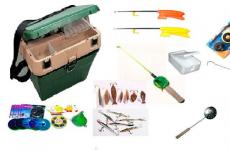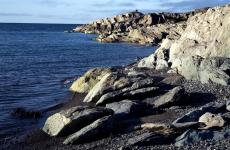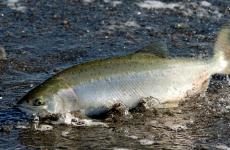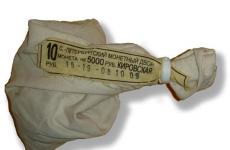From Vilnius to Trakai on your own. Kaunas Vilnius Trakai
Trakai is a small town 27 km from the capital of Lithuania, Vilnius. In the past, it was the political center of the state, and now it is the capital of Lithuanian tourism. In addition to the well-known Trakai Island Castle, this city has many other attractions.
To the legends of antiquity
If you leave Vilnius along the Berlin E 28 highway to the west, then 27 km after crossing the city limits you will find yourself in an amazing land of hundreds of large and small forest lakes. Its capital is the town of Trakai. Now it is a small settlement, with just over five thousand inhabitants. But five hundred years ago it was the center of gravity of the political life of Medieval Europe.
The fact is that the entire political history of this area began a little to the south, in the village of Seneyi Trakai or Starye Troki, which can be reached by turning off E 28 at the first traffic intersection to the southeast. After three kilometers you will get to where at the end of the 13th and beginning of the 14th centuries the Grand Duke of Lithuania Gediminas founded his residence. In the middle of the 14th century, the first stone castle on Troki soil was built there. It has not survived to this day. Now in its place stand a church in the neo-Gothic style, built in the mid-19th century, and the ruins of a Benedictine monastery.
Trakai starts north of the E 28 highway. It stands on a narrow isthmus between lakes Luka and Totoriskes, and from the north it is pressed by Lake Galvė, where the very “postcard” castle stands. Trakai was founded in the first third of the 14th century by Gediminas' son Keistut. It was in this city that the no less legendary Grand Duke of Lithuania Vytautas was born, who made it his main residence and lived there all his life until 1430. From this city the Lithuanian army left for the Battle of Grunwald with the Teutonic Order.
The city lived and developed, had political weight until the 16th century, when it lost all significance and finally ceded its rights to Vilnius (Vilno). The location, which was too constrained by lakes, also played a significant role in its decline. During the Russian-Polish war of the 17th century, the city was plundered and burned, its castles (there were already three at that time) were destroyed.
It remained in such a deplorable state until the mid-20th century, when interest in the history of this place prompted the authorities to restore the city’s landmarks.
Sights of Trakai
 The first thing you can see on the way to the castles is the Church of the Nativity of the Blessed Virgin Mary. This is the only Orthodox church today, built in 1863. For its construction, Grand Duke Alexander Alexandrovich donated a gilded tabernacle.
The first thing you can see on the way to the castles is the Church of the Nativity of the Blessed Virgin Mary. This is the only Orthodox church today, built in 1863. For its construction, Grand Duke Alexander Alexandrovich donated a gilded tabernacle.
Further north stands the Catholic Church of the Apparition of the Blessed Virgin Mary. It was built in 1409 by order of Prince Vytautas in the medieval Gothic style. In the 18th century it was rebuilt in the Baroque style. From the Trakai bus station it takes about ten minutes to walk to the church. You can visit it daily from nine in the morning to seven in the evening.
The next attraction is the chapel of St. Jonas Nepomukas, the city’s patron saint. It stands at the intersection of Karaimu and Vytauto streets. This is a white stone pillar on a rectangular base with a gazebo and a tent top.
At the intersection of Karaimu and Kosciuszki streets there is a one-story post office building, a legacy of the Russian Empire.
Literally next to the post office building there is an 18th-century Dominican monastery. It is open to the public from ten in the morning.
There is an exhibition of sacred art there. To see it, you need to buy a ticket for 4 litas. For schoolchildren and students, curiosity will cost half as much.
 Even further north, in front of the bridge leading to the island castle of Trakai, stands the prayer house of the Kenassa Karaites, built in the 16th century.
Even further north, in front of the bridge leading to the island castle of Trakai, stands the prayer house of the Kenassa Karaites, built in the 16th century.
One attraction of Trakai is located outside of it, on the shores of Lake Galve. This is Užutrakis, the estate of Józef Tyszkiewicz - the largest regular French park in Lithuania with a palace and outbuildings, built in the 19th century. You can get to Lithuanian Versailles around Lake Galvė from the Trakai bus station. A full ticket to visit it costs 10 litas.
Trakai Castle
There are two castles in this city: peninsular and island,widely advertised.
Peninsula Castle
 It received this name for its position. It is located on a peninsula separating lakes Luka and Galve. The time of its construction dates back to the end of the 14th century.
It received this name for its position. It is located on a peninsula separating lakes Luka and Galve. The time of its construction dates back to the end of the 14th century.
This one of the largest defensive structures of Medieval Europe. Its area is 4 hectares. The castle was separated from the mainland by a wide ditch, now filled in. It consisted of two parts: a forefield, with five square towers and walls 3.2 meters thick, as well as a citadel, separated from it by an additional moat. In it, on a high mound called the “Hill of Sacrifice,” there was a small wooden fortification beyond the stone walls.
In total, this castle had 11 defensive towers. The fortress on the peninsula quite successfully repelled the attacks of the Teutonic knights in the 14th and 15th centuries, was repeatedly destroyed and rebuilt. It was turned into ruins only during the war between Russia and Poland in the middle of the 17th century. Five powerful square towers, the bases of the walls and the gates connecting the two parts of the castle have survived to this day. Later, in the 18th century, the construction of a Dominican monastery was started on the territory of the foreground. But the ruins of the fortress turned out to be so strong that it was not possible to break enough material from them to complete the construction, so by the 19th century the work stalled.
Now on the territory of the castle there is a historical park, where colorful performances by fans of historical reconstructions, folklore celebrations and festivals are often held. You can enter its territory for free from ten in the morning.
Trakai Island Castle
 Trakai Island Castle was built by order of the Grand Duke of Lithuania Vytautas in 1409 on the island of Piles, two hundred and twenty meters from the shore of Lake Galvė. It is connected to the mainland by a narrow bridge. It was built at a time when the Grand Duchy of Lithuania was on the verge of adopting Catholicism as the only state religion. Therefore, Lithuania’s relations with the Teutons were so good that the construction of the impregnable citadel was supervised by the Order’s chief mason, Rathe. So, within a cannon shot of each other, two such dissimilar fortifications appeared - a Slavic peninsular castle and a Gothic island castle with red-brick walls on a rubble stone base.
Trakai Island Castle was built by order of the Grand Duke of Lithuania Vytautas in 1409 on the island of Piles, two hundred and twenty meters from the shore of Lake Galvė. It is connected to the mainland by a narrow bridge. It was built at a time when the Grand Duchy of Lithuania was on the verge of adopting Catholicism as the only state religion. Therefore, Lithuania’s relations with the Teutons were so good that the construction of the impregnable citadel was supervised by the Order’s chief mason, Rathe. So, within a cannon shot of each other, two such dissimilar fortifications appeared - a Slavic peninsular castle and a Gothic island castle with red-brick walls on a rubble stone base.
This castle also consists of two parts: the bridgehead and the citadel, where the princely palace is located. They were separated by a ditch filled with lake water.
The princely palace was built on three floors; in plan it resembles the letter “P”. Later it was closed with a six-story quadrangular tower-donjon, which became the symbol of the Trakai Island Castle, and a brick wall was built around the palace. The only way to get from the bridgehead to the princely palace is through the arch of the donjon gate.
The bridgehead of an irregular trapezoidal shape was erected on three small islands, the channels between which were covered with soil. The height of its walls is about seven meters, and the thickness is three and a half. It had four towers: three round on a square base and a square passage with a gate.
Until 1655 it was a fortress that never surrendered to siege. Russian troops succeeded, after which the castle was burned and destroyed. It remained in ruins until the end of the 19th century. After this, attempts were made to restore it.
 Actual work began only in 1935 ,
after several years of studying and measuring the ruins. By 1949, with a break for the war, the main hall of the palace and its roof were restored. Large-scale work on the restoration of the castle began in 1951, but was suspended for political reasons: they were opposed by the party leadership of Lithuania in 1961. Since 1962, the Trakai Museum has been located in the castle, so work was carried out under the leadership of historians Stanislovas Mikulionis and Bronius Kruminis, although not very well intensively. By 1987, the two towers on either side of the entrance were restored, and the castle took on the appearance of the 15th century.
Actual work began only in 1935 ,
after several years of studying and measuring the ruins. By 1949, with a break for the war, the main hall of the palace and its roof were restored. Large-scale work on the restoration of the castle began in 1951, but was suspended for political reasons: they were opposed by the party leadership of Lithuania in 1961. Since 1962, the Trakai Museum has been located in the castle, so work was carried out under the leadership of historians Stanislovas Mikulionis and Bronius Kruminis, although not very well intensively. By 1987, the two towers on either side of the entrance were restored, and the castle took on the appearance of the 15th century.
Now in this, without a doubt, unique, the only island medieval fortress in Europe, there is a museum, excursions and historical holidays are held. You can get there:
- From Monday to Saturday, if it is from May to September.
- In March, April, October, November, December and February from Tuesday to Sunday inclusive.
Opening hours are from 10 am. An adult ticket costs 15 litas. Elderly people are given a discount of 5 litas. For students and schoolchildren, a ticket will cost 7 litas. If you want to take photographs on the museum grounds, then prepare another 4 litas.
How to get to Trakai
There are two ways to get from Vilnius to Trakai:
- By bus.
- By rail.
The bus station, from where buses depart to Trakai almost every half hour, is located on Sodu Street 22. From the bus station in Trakai to the castle it is only a 30-minute leisurely walk.
To take the train, go to Geležinkyalő Street in Vilnius. There is a train station there.
The regular bus usually departs on the following days of the week:
- Sunday
- Monday
- Tuesday
- Thursday
- Friday
- Saturday
To view the bus schedule Trakai - Vilnius for a specific date, select the travel date and click the “Find” button in the search form at the top of the page, or click on the desired date in the calendar on the right.
Numbers of buses that operate on the route
- UAB TOKS (Eurolines BC), bus number: "M-912", "M-912 Kaunas - Prienai - Birštonas - Jieznas - Trakai - Vilnius"
Flight statistics for the last 7 days:
Prices for bus tickets Trakai - Vilnius
The average cost of travel by bus from Trakai to Vilnius fluctuates around 165 rubles.
The cheapest ticket found by our users over the last week costs 156 rubles. for one adult from the company UAB TOKS (Eurolines BC).
Distribution of prices for bus tickets Trakai - Vilnius by company:
- UAB TOKS (Eurolines BC) — 156 rub.
The list displays the minimum prices for tickets found in our system over the last 7 days. The cost depends on the day of the week and time of purchase. Tickets departing on weekends and holidays are usually more expensive.
A return ticket from Vilnius to Trakai costs from 367 rubles per adult.
Trakai Castle: is it worth going, how to get there, how much does it cost?

One of the best attractions in Lithuania is a magical castle with a red tiled roof located on the shore of a lake. The castle is open to visitors all year round; you can take a tour, but even without a guide’s story, it will certainly impress you. You can ride a boat or yacht, take a walk in the park, stroll through the cozy town of Trakai, buy original souvenirs, and try local cuisine in one of the cute cafes.
This incredibly colorful place is a must-see, and the journey from Vilnius will take no more than half an hour.
Entrance fee to the castle: 6 euro
How to get to Trakai and how much it costs
By bus from Vilnius bus station
Buses leave every half hour and take you to the town of Trakai, where the castle is located, in 45 minutes. Tickets can be purchased at the bus station ticket office. Fare from 2 euros.
By train from Vilnius railway station
Every half hour a train leaves from Vilnius railway station, which takes you to Trakai for 1.70 euros and takes half an hour. Tickets can be purchased on the official website or at the railway station ticket office.
By taxi
The castle is located 30 km from the capital, so you can easily get there by taxi. Fare from 35 euros.
Kaunas: is it worth going, how to get there, how much does it cost

A small but very beautiful ancient city just 100 km from Vilnius.
Kaunas is famous for the architecture of the old center, stunningly beautiful churches, the 14th century Kaunas Castle located by the river, the open-air ethnographic park-museum, and numerous museums.
Kaunas is a great place to relax both in nature and in the city; there are a huge number of parks. Residents and guests of the city appreciate it for the opportunity to relax by the water - not far from the city there are beaches at the picturesque city reservoir, surrounded by forest, and at Lake Lampedžiai, and along the river you will find wonderful green lawns where you can have a picnic or just sunbathe. Kaunas is conducive to a calm, peaceful holiday.
How to get to Kaunas and how much it costs
By bus
Buses to Vilnius depart from Kaunas bus station every hour. Fare approximately 6 euros. Tickets can be purchased at the station ticket office. Travel time is 1.5 hours.
By train
Trains to Vilnius depart from Kaunas railway station. Fare approximately 5-6 euros. Tickets can be purchased at the railway station ticket office. Travel time is an hour and a half. When purchasing tickets, inquire about transfers along the way and carefully read what is written on the ticket.
By plane
Kaunas Airport is located approximately 10 km from the city center. It accepts both domestic and international flights. You can get from the airport to the city by bus for 1-2 euros or by taxi, which you can easily find right at the terminal for about 20 euros.
Only charter flights fly from Russia to Kaunas. Regular flights fly to Vilnius, and from there Kaunas is easily accessible by bus or car.
Druskininkai: is it worth going, how to get there, how much does it cost

A water park famous throughout Lithuania, a snow arena for skiing at any time of the year, parks, forests, amazing nature, saunas, steam baths, spa complexes, bars, cafes, restaurants, budget and luxury hotels - all the best for your vacation is located here, in Lithuania’s favorite resort - Druskininkai. Everything is treated here: from bad mood to diabetes. The mineral waters, healing mud, and healing air of Druskininkai are known throughout Europe, so if you have free time, be sure to come visit at any time of the year.
How to get there and how much it costs
The city is located 100 km from Vilnius and can be reached by bus.
By bus
Buses depart every hour from Vilnius bus station to Druskininkai. Travel time is 2 hours. Fare 10 euros. Tickets can be purchased at the bus station box office or online on this website.
Klaipeda: is it worth going, how to get there, how much does it cost

Klaipeda bears the proud title of the main port of Lithuania, but it is not only the business heart of the country, but also a stunningly beautiful place for recreation. Amazing German architecture, sea air, elegant but noisy seagulls, beautiful nature of the Curonian Spit, endless white dunes - Klaipeda is magnificent!
In Klaipeda, you can leisurely walk around the city and admire the half-timbered houses, drink cocktails in bars and coffee on the terraces, wrapped in a blanket, ride a ferry, feed seagulls and pigeons, enjoy amazing views of sand dunes and breathe the sea.
How to get there and how much it costs
Klaipeda is located 309 km from Vilnius and can be reached by plane, bus and ferry.
On a ferryboat
Regular ferry service has been established between Gdansk (Poland), Copenhagen (Denmark), Kiel and Lübeck (Germany). Tickets can be purchased at the ferry ticket offices of these cities.
By train
Every day, high-speed trains depart from Vilnius railway station to Klaipeda. Travel time is 4 hours. Fare 10-15 euros.
By bus
Buses depart daily from Vilnius bus station to Klaipeda. Travel time is 4 hours. Fare 13-20 euros. Tickets can be purchased at the bus station ticket office.
Related articles that may interest you:
 |
|
On the second day of our stay in Vilnius, after visiting all the main attractions of the capital of Lithuania (once and twice), we decided to visit the city of Trakai, where one of the most beautiful and majestic castles is located, which has never been conquered - Trakai Castle.
Our apartment was a seven-minute walk from the bus station, which made any trip from Vilnius to other cities a breeze.
At 7 am we got up. And at 8:15 we were already leaving the central bus station of Vilnius on a nice, albeit old bus, having paid 1.77 euros per person for a ticket.
The distance from Vilnius to Trakai is only 27 kilometers, which translates into approximately 30-40 minutes drive. Buses run every half hour.
The only thing, keep in mind that it is better to leave Trakai back before 12:00. Because the next bus will only be at 13:30. And spending an hour and a half in a city where, apart from Trakai Castle, there is nothing special to see, is a dubious pleasure.
Trakai is a small town. Its area is about 12 kilometers, and only about 5,500 people live on its territory.
From the local Trakai bus station to the castle it is about 2 km. Unfortunately, you can only get there on foot or by your own car, because... There is no public transport to the Castle. At least that's what we were told.
However, the walk to Trakai Castle was interesting. Time after time, we saw nice private houses for rent, churches and other architectural structures.
If someone needs to buy something, on the way to the Castle you will pass by several large supermarkets.
Trakai Castle
The castle is located in the middle of the deep Lake Galvé. From a distance he seems like a mighty silent warrior. Needless to say, if the developed system of defensive structures made the castle impregnable. It has never been conquered.
Trakai Castle is the only castle in Eastern Europe built on an island and one of the largest castles in Lithuania.
To get to it you need to cross two wooden bridges. One of them will take you to the monument to the Grand Duke of Lithuania
And the second - already up to the castle.
At the entrance to the fortress there is a map. To the left is the cash register window.
The ticket price for visiting Trakai Castle is 5.21 euros per person. For the opportunity to take photographs in the castle, they will charge you another euro.
We buy tickets and go look around.
The castle is a magnificent example of Gothic architecture and consists of several parts: the so-called pre-castle (inner courtyard), the donjon, and the prince's palace.
The princely palace is located in the very center, surrounded by a thick fortress wall and protected by defensive towers.
We go up the stairs and go to the Prince's palace.
Along the way we find a shooting gallery.
Here you can shoot with a bow or rifles.
A little more and we are at the goal.
This is the courtyard of the palace.
The living quarters of the castle were connected to each other by internal wooden galleries.
And between the prince’s bedroom and the treasury chamber there was a secret passage that led to the courtyard.
The castle was equipped with an air heating system: hot air rose through the pipes and warmed the cold stone walls
Representative hall
This is the most elegant room in the Castle. It occupies the entire right wing of the first floor.
The walls of the hall are authentic. The windows of the hall were decorated with stained glass and frescoes, the main subjects of which were scenes from the life of the great princes.
During the reign of the Grand Duke of Lithuania Vytautas, and also after his death, kings and ambassadors of neighboring and distant countries were received in this hall. Here treaties were signed, balls were held, and the prince’s council also met.
Nowadays, the hall is used for various social events. The hall has excellent acoustics, so it often hosts various concerts of chamber and medieval music.
It has also become very popular to award graduation certificates to students of Trakai schools.
Courtroom
In the 16th century, a class system of courts was formed in the Grand Duchy of Lithuania: Castle, Zemsky and Podkormsky.
Each of these ships had its own specialization. The Castle Court heard criminal cases. Zemsky - civilians. Podkormsky – land.
Castle courts were subordinate to elders or governors, who appointed officials in this court (president, judge and scribe).
Subsequently, the Castle Court was abolished, and its functions were transferred to the Zemsky Court, and later to the Regional Court.
Trakai History Museum
And, of course, the Trakai Historical Museum is located in the Castle. It was founded in 1948 and is an integral historical component of the castle. There are a lot of different interesting exhibits, gizmos and interior items from those distant times on display here. According to preliminary estimates, about 300,000 valuables.
These include abundant collections of furniture, hunting trophies, pipes, seals, items made of enamel, porcelain, glass, beads, and bone items.
Let the photos speak for me
This is a comparison of the materials from which the castle was built and those used in its restoration.
I was especially delighted by the entire installations of actions and events of past times.

When my wife and I were walking around the neighborhood, we witnessed a comical situation. The brave dog Myra decided to hunt a duck. She jumped into the water after the bird and, like a shark, smelling blood, pursued the prey to the last.
This continued until the duck flapped its wings and flew to another place.
The dog turned around and swam back to the shore.
However, as soon as the duck appeared nearby again, Myra again set off in pursuit.
These dogs are so forgetful.
Well, I hope you enjoyed the tour of Trakai Castle. In the next article I will tell you where you can eat inexpensively in Vilnius and which restaurants to visit.
See you!
On the second day of our stay in Vilnius, after visiting all the main attractions of the capital of Lithuania (once and twice), we decided to visit the city of Trakai, where one of the most beautiful and majestic castles is located, which has never been conquered - Trakai Castle.
Our apartment was a seven-minute walk from the bus station, which made any trip from Vilnius to other cities a breeze.
At 7 am we got up. And at 8:15 we were already leaving the central bus station of Vilnius on a nice, albeit old bus, having paid 1.77 euros per person for a ticket.
The distance from Vilnius to Trakai is only 27 kilometers, which translates into approximately 30-40 minutes drive. Buses run every half hour.
The only thing, keep in mind that it is better to leave Trakai back before 12:00. Because the next bus will only be at 13:30. And spending an hour and a half in a city where, apart from Trakai Castle, there is nothing special to see, is a dubious pleasure.
Trakai is a small town. Its area is about 12 kilometers, and only about 5,500 people live on its territory.
From the local Trakai bus station to the castle it is about 2 km. Unfortunately, you can only get there on foot or by your own car, because... There is no public transport to the Castle. At least that's what we were told.
However, the walk to Trakai Castle was interesting. Time after time, we saw nice private houses for rent, churches and other architectural structures.
If someone needs to buy something, on the way to the Castle you will pass by several large supermarkets.
Trakai Castle
The castle is located in the middle of the deep Lake Galvé. From a distance he seems like a mighty silent warrior. Needless to say, if the developed system of defensive structures made the castle impregnable. It has never been conquered.
Trakai Castle is the only castle in Eastern Europe built on an island and one of the largest castles in Lithuania.
To get to it you need to cross two wooden bridges. One of them will take you to the monument to the Grand Duke of Lithuania
And the second - already up to the castle.
At the entrance to the fortress there is a map. To the left is the cash register window.
The ticket price for visiting Trakai Castle is 5.21 euros per person. For the opportunity to take photographs in the castle, they will charge you another euro.
We buy tickets and go look around.
The castle is a magnificent example of Gothic architecture and consists of several parts: the so-called pre-castle (inner courtyard), the donjon, and the prince's palace.
The princely palace is located in the very center, surrounded by a thick fortress wall and protected by defensive towers.
We go up the stairs and go to the Prince's palace.
Along the way we find a shooting gallery.
Here you can shoot with a bow or rifles.
A little more and we are at the goal.
This is the courtyard of the palace.
The living quarters of the castle were connected to each other by internal wooden galleries.
And between the prince’s bedroom and the treasury chamber there was a secret passage that led to the courtyard.
The castle was equipped with an air heating system: hot air rose through the pipes and warmed the cold stone walls
Representative hall
This is the most elegant room in the Castle. It occupies the entire right wing of the first floor.
The walls of the hall are authentic. The windows of the hall were decorated with stained glass and frescoes, the main subjects of which were scenes from the life of the great princes.
During the reign of the Grand Duke of Lithuania Vytautas, and also after his death, kings and ambassadors of neighboring and distant countries were received in this hall. Here treaties were signed, balls were held, and the prince’s council also met.
Nowadays, the hall is used for various social events. The hall has excellent acoustics, so it often hosts various concerts of chamber and medieval music.
It has also become very popular to award graduation certificates to students of Trakai schools.
Courtroom
In the 16th century, a class system of courts was formed in the Grand Duchy of Lithuania: Castle, Zemsky and Podkormsky.
Each of these ships had its own specialization. The Castle Court heard criminal cases. Zemsky - civilians. Podkormsky – land.
Castle courts were subordinate to elders or governors, who appointed officials in this court (president, judge and scribe).
Subsequently, the Castle Court was abolished, and its functions were transferred to the Zemsky Court, and later to the Regional Court.
Trakai History Museum
And, of course, the Trakai Historical Museum is located in the Castle. It was founded in 1948 and is an integral historical component of the castle. There are a lot of different interesting exhibits, gizmos and interior items from those distant times on display here. According to preliminary estimates, about 300,000 valuables.
These include abundant collections of furniture, hunting trophies, pipes, seals, items made of enamel, porcelain, glass, beads, and bone items.
Let the photos speak for me
This is a comparison of the materials from which the castle was built and those used in its restoration.
I was especially delighted by the entire installations of actions and events of past times.

When my wife and I were walking around the neighborhood, we witnessed a comical situation. The brave dog Myra decided to hunt a duck. She jumped into the water after the bird and, like a shark, smelling blood, pursued the prey to the last.
This continued until the duck flapped its wings and flew to another place.
The dog turned around and swam back to the shore.
However, as soon as the duck appeared nearby again, Myra again set off in pursuit.
These dogs are so forgetful.
Well, I hope you enjoyed the tour of Trakai Castle. In the next article I will tell you where you can eat inexpensively in Vilnius and which restaurants to visit.
See you!














































